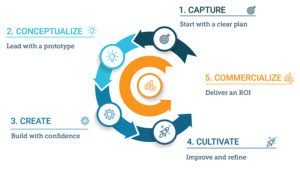Last updated on March 29th, 2024 at 10:27 am
Here's how to get started with E-Learning Development
It is mistakenly thought that e-learning can be imparted by adding audio to PowerPoint presentations and posting them online. Also, e-books, videos, and PDFs do not constitute e-learning. True e-learning goes beyond this.
True e-learning is enabled by technology. In e-learning, technology is used in the design and development of the learning module, its delivery, the evaluation of the training, and also in its administration.
 E-learning development training has grown to be the second-most popular training methodology (only behind instructor-led training) and accounts for nearly a third of the training budgets.
E-learning development training has grown to be the second-most popular training methodology (only behind instructor-led training) and accounts for nearly a third of the training budgets.
The popularity of e-learning is growing, mainly due to its self-paced nature and the learn-anywhere convenience.
E-learning is especially suitable for organizations with a globally dispersed workforce, for whom traditional approaches to training would be too cumbersome and expensive.
Getting Started with E-Learning
Organizations embarking on their e-learning development journey can attempt this process in the following stages:
- Introductory stage: It is best to commence with training that appeals to the employees.
- Scaling up: Use this stage to standardize the processes.
- Centralization: Transition to organization-wide learning.
- Institutionalize: Graduate to embed learning in the organizational culture.
Like any change initiative, e-learning will have its share of naysayers. Before starting the implementation of e-learning, check for:
- Need: Will e-learning contribute to the sale of your products or enhance efficiency?
- Readiness: Are the organization and the people ready to embrace the technology? If not, prepare the organization and the people for this technology.
- Availability of Infrastructure: Use a suitable Learning Management System (LMS) to support e-learning.
- Content: Prepare e-learning content to meet targeted training objectives.
Rolling Out E-Learning
E-learning can be rolled out in the following steps:
- Use an open-source yet reliable LMS such as Moodle.
- Kick-start the e-learning initiative with mandatory programs, such as safety training.
- Convert material from instructor-led training into the e-learning format incorporating the necessary design and functionality.
- Pick an authoring tool based on the training need, the expertise available to use the tool, and readiness within the organization to adopt e-learning.
- Initially, run a pilot of the e-learning program with a mix of students.
Implementation Challenges
Every stage of implementation comes with its unique set of challenges:
- Introductory Stage: The factors that make this stage challenging are obtaining buy-in, integrating e-learning with the overall training framework, deciding the appropriate authoring tool, choosing an LMS, etc. This stage is best handled by starting small and with a training program relevant to most employees - for example, compliance or safety.
- Scaling Up: Challenges during this stage include driving organization-wide adoption, balancing standardization and creativity, deciding on the quantum of outsourcing, etc. The challenges during the scaling-up phase are best addressed by focusing on process standardization and partnering with a training services provider.
- Centralization Stage: The challenges in this stage involve increasing LMS usage, renewing content, updating the authoring tool, etc. These challenges can be overcome by nominating suitable people to champion e-learning and creating an e-learning-friendly organization.
- Institutionalization: At this stage, it is crucial to have an analytics tool to evaluate ROI. Institutionalization is best achieved by identifying suitable people and assigning them the responsibility of making the organization e-learning friendly.
Should E-Learning Be Outsourced?
If expertise is inadequate, then routine activities can be undertaken in-house. On the other hand, activities requiring specialized skills such as translation, development of videos, Flash to HTML5 conversion, etc., can be outsourced.
It is also better to outsource if the project is large. Outsourcing provides you with access to experts across various facets of e-learning, such as authoring tools, learning design, etc. With this available expertise, scaling becomes easier and faster.
Final Thoughts
E-learning is a highly cost-effective and efficient method of imparting training. With many e-learning service providers in the market, choosing the right one becomes critical.
Imarticus Learning specializes in such partnerships and helps organizations gain cost savings, increased efficiency, and a significant competitive advantage.
Through its corporate development and training programs, Imarticus has trained over 35,000 professionals from leading firms such as IBM, KPMG, Genpact, Moody's Analytics, Motilal Oswal, etc.





